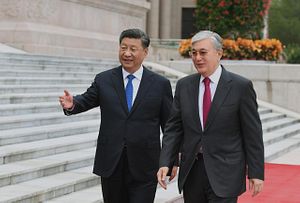President Kassym-Jomart Tokayev of Kazakhstan was in Beijing this week for a two-day state visit. Tokayev and Chinese President Xi Jinping announced their intent to elevate bilateral ties to a permanent comprehensive strategic partnership.
This was Tokayev’s first visit to China since being hand-picked as Nursultan Nazarbayev’s successor and formally elected in June 2019. Tokayev has history in China, having spent time in there for studies, training courses, and postings as a member of the Soviet Ministry of Foreign Affairs.
Kazakhstan, a former Soviet satellite state, still maintains strong connections to the Russian Federation, but has steadily expanded its political and economic relations with neighboring China. The two countries settled their borders in the late 1990s and were also co-founders of the regional Shanghai Cooperation Organization. More recently, Kazakhstan seems to have become an important pillar in the rollout and implementation of China’s pursuit of greater regional connectivity in Asia as embodied in Xi Jinping’s Belt and Road Initiative. Xi’s announcement of a new Silk Road — one branch of what we now call the BRI — in 2013 was made in a speech at Kazakhstan’s Nazarbayev University, a strategic and symbolic nod to the expansion of bilateral ties. In the past six years, meetings and exchanges between top officials from both countries have heralded multi-billion dollar investments and emphasized the benefits and successes of projects in Kazakhstan.
The bilateral relationship has significant perks for China, notably its need for access to resources. Kazakhstan’s oil, natural gas, and minerals are of particular interest. Over the past decade and a half, Chinese firms have poured billions of dollars into various industries, including energy, infrastructure, and petrochemicals. In kind, Kazakhstan has boosted its oil and natural gas exports to China, and has vowed to increase grain sales to China. The two countries have also cooperated on water, related to their respective supply and management systems, as they share around two dozen rivers.
For Kazakhstan, China is a pivotal trade partner, as well as a much needed source of capital to help develop the country. In a March 2019 editorial in China’s Global Times, Kazakh Foreign Minister Beibut Atamkulov wrote “In China, Kazakhstan has found a major strategic partner, a long-term collaborator and reliable neighbor.” Two way trade has made remarkable strides over the past several decades, making China one of Kazakhstan’s most important trade partner after Russia. In 2017, China was the source for nearly 16 percent of Kazakhstan’s imports, while it was the destination for nearly 12 percent of the Central Asian state’s exports. These numbers are up from less than 1 percent of import share and just over 5.4 percent of export share in 1995, according to World Bank data.
But not all financial deals have been hassle-free with some slowed or stalled Chinese state-backed funding, including in response to opposition of Chinese purchases of stakes in national energy firms and other stumbling blocks in the development of the light-rail system in the Kazakh capital.
Although the official narrative coming out of Nur-Sultan (formerly known as Astana) paints a rosy picture of China-Kazakhstan ties, its obscurse a more complicated reality on the ground, revealing pockets of discontent relating and rising anti-Chinese sentiment. Under Nazarbayev’s tenure, periodic anxiety about China’s presence in Kazakhstan boiled over into protests. Plans for land reforms in early 2016 that would have permitted Chinese to purchase Kazakh plots of land triggered widespread protests.
More recently, protests in the southwestern town of Zhanaozen erupted as people gathered to oppose the construction of Chinese plants to the area over pollution concerns; the rallies continued for several days and spread to the capital and the city of Almaty. Notably, Zhanaozen, despite its relatively small size, is known for being restive and was the site of violence between protesting oil workers and police in 2011 that left more than a dozen people dead — still a sensitive issue for the government. Another potential souring point in the China-Kazakhstan relationship is the recent detention by Kazakh counterintellingence authorities of Konstantin Syroyezhkin, a sinologist and senior government advisor, who faces espionage charges.
Separately, Beijing’s restrictive policies and detention centers in Xinjiang have not only targeted Uyghurs but ethnic Kazakhs in China as well, making the situation a domestic issue in the Central Asia state. According to Bruce Pannier of RFE/RL, China is home to the largest Kazakh diaspora with an estimated 1.25 million to 1.5 million Kazakhs residing in northern parts of Xinjiang. The government has been tested in how to handle the treatment of Kazakhs in China, especially as one activist has sought asylum in Sweden after fleeing Xinjiang via Kazakhstan, while Kazakh authorities separately arrested and charged a Xinjiang rights activist for inciting inter-ethnic discord.
The schism between the official take on the Beijing-Nur-Sultan relationship and popular sentiment seems to be intensifying. A larger debate about Chinese presence could emerge in the public realm amid heightened scrutiny over investment choices and flashpoints about ethnic divisions. Acceptance of dissent and popular deliberation in the political arena have not been traditional features of Kazakhstan’s political makeup. While high level people to people ties between Beijing and Nur-Sultan seem as strong as ever, managing the China question at home may yet present itself to be a mounting challenge for Kazakh leadership.
































